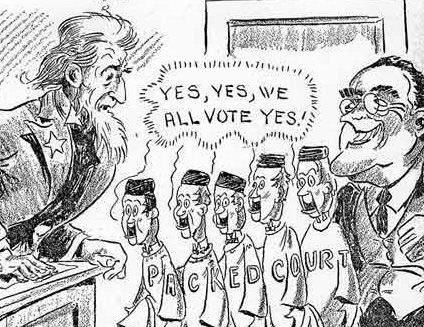By Kaleena Fraga
The 14th amendment guaranteed all citizens “equal protection of the laws”, effectively ending the 3/5 Compromise enshrined in the Constitution (stating that states could count black people as 3/5 of a person). As president, Andrew Johnson fought against the 14th amendment and convinced southern states to do the same. Following his lead, southern states refused to ratify it. Still, the amendment was ratified on July 9th, 1868. It was followed by the 15th amendment, which ensured equal voting rights, regardless of race.
This was, Grant said during his presidency, a mistake.
Grant was no racist–far from it–but he recognized the inherent problem of states disenfranchising voters, while using their bodies as tallies toward their power in the electoral college.
What was it about the 14th and 15th amendments that Grant didn’t like?
Grant’s secretary of state, Hamilton Fish, recorded Grant’s thoughts during a particularly tense point in his presidency. The recent presidential election–which would eventually put Rutherford B. Hayes in office–had been highly contested, and Grant and Fish had heard reports from Louisiana that stated that black voters had been so terrorized that “overwhelmingly Republican parishes had ended up in Democratic columns.” A Senate investigation even later uncovered that in one parish 60 black Republicans had been murdered before the election.
Fish wrote of Grant, “He says he is opposed to the XV amendment and thinks it was a mistake; that it had done the negro no good, and had been a hindrance to the South, and by no means a political advantage to the North.”
Grant later clarified what he meant: “[The South] keep[s] those votes, but disfranchise[s] the negroes,” he told journalist John Russell Young. “That is one of the gravest mistakes of reconstruction.” In other words, the 14th amendment increased the population of the South, which gave southern states more heft in the electoral college. So although the South suppressed the black vote, it could count them fully for election purposes. The result was an imbalance of power.
Grant saw it as his prime responsibility–indeed, the prime responsibility of the government–to ensure that everyone had safe, easy access to voting. “I will not hesitate to exhaust the powers thus vested in the Executive,” he said, “for the purpose of securing to all citizens of the United States the peaceful enjoyment of the rights guaranteed to them by the Constitution and laws.”
Grant oversaw the passage of the Civil Rights Act of 1875, which outlawed racial segregation in public accommodations, schools, transportation, and juries. Democratic states did not bother to enforce it, and it was struck down by the Supreme Court in 1883 as unconstitutional. It would take almost 100 years for Congress to attempt anything similar.
It wasn’t until 1957 that Congress passed another civil rights bill; and it wasn’t until 1964 that laws first proposed in 1875 were enshrined into law. Then, in 1965 the country saw the Voting Rights Act, which enabled fair voting to the very citizens that Grant sought to protect, 90 years earlier.
Ulysses S. Grant’s presidency was a long time ago, but his mission, to protect voters, is today more important than ever.
In 2013, the Supreme Court struck down key tenets of the Voting Rights Act. Chief Justice John Roberts, writing the majority opinion, stated that such protections were no longer needed because “our country has changed” for the better. “While any racial discrimination in voting is too much,” Roberts wrote, “Congress must ensure that the legislation it passes to remedy the problem speaks to the current conditions.”
Since 2013, it’s become harder for Americans to vote. In light of the 2013 ruling, southern states have closed at least 868 polling places–the Voting Rights Act of 1965 allowed the Department of Justice to stop closures like these, but that part of the legislation was struck down. Vox points out that these 868 closures are in about half of the counties that were once targeted by the Voting Rights Act because of their history of racial discrimination. This means that there could be hundreds, or perhaps thousands, of closures that are untracked.
In 2018, the United States faces the same problem it faced in the 1860s and 1870s. Americans have a limited ability to vote. Those who work long hours, or shifts, or live far away from polling places, face difficulties having their voices heard. Yet they are still counted, and states can use their bodies (even while it silences their voices) on the electoral stage. To Grant, this oversight on the part of the U.S. government would be nothing less than a dereliction of duty.

